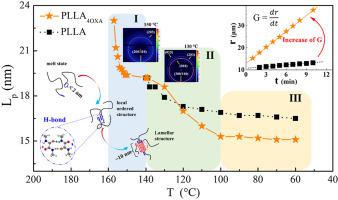Polymer ( IF 4.6 ) Pub Date : 2022-06-08 , DOI: 10.1016/j.polymer.2022.125031 Manman Yu , Youpei Du , Pengwu Xu , Weijun Yang , Pingxia Zhang , Tianxi Liu , Pieter Jan Lemstra , Piming Ma

|
The role of hydrogen bonding (H-bonding) in polymer nucleation and crystallization is not yet so clear. To understand this physical issue, a series of poly (L-lactide) (PLLA) with different amount of terminal oxamide segments (OXA, -NHCOCONH-) were tailor-made as model H-bonding polymers (PLLAnOXA, n is the number of –NHCO–), and then the influence of H-bonding on the polymer nucleation and crystallization were investigated by a combination of experiments and molecular dynamics (MD) simulations. Compared with PLLA, much more types of H-bonds are created between the OXA segments and either the PLLA chains or the other OXA segments in the PLLAnOXA systems. A segment can be immobilized in the melt by H-bonding induced topological constraint and/or steric hindrance leading to a certain extent of reduction in entropy. Thus, the pair of H-bonded segments acting as a precursor of the “first stems” is expected to inducing local ordered structures (LOS) at elevated temperatures, which further facilitates the formation of both primary and secondary nuclei. As a consequence, the nOXA segments induced H-bonds not only significantly enhanced the crystallization temperature (Tc, from 100 °C to 112 °C) and the crystallinity (Xc, from 10% to 52%) of PLLA, but also increases the crystal growth rate (G) by nearly 10 times (from 0.25 to 2.66 μm min−1 at 150 °C). Moreover, a HI-MS (H-bond induced multi-stage) nucleation phenomenon in the melt of the PLLAnOXA was revealed by in-situ small-angle X-ray scattering (SAXS) under both non-isothermal (1 °C/min) and isothermal (135 °C) conditions. The HI-MS nucleation mechanism is well correlated to the nOXA induced multi-types of H-bonds which possess different thermodynamical stability at a certain high temperature. Therefore, this work not only provides a new route to make rapid crystallizing PLLA via hybridizing H-bonding segments, but also provides a molecular-level insight in the H-bonding assisted nucleation of semi-crystalline polymers in general.
中文翻译:

末端氢键段辅助聚(L-丙交酯)的成核和结晶
氢键(H-键)在聚合物成核和结晶中的作用还不是很清楚。为了理解这个物理问题,我们定制了一系列具有不同数量的末端草酰胺链段(OXA,-NHCOCONH-)的聚(L-丙交酯)(PLLA)作为模型 H 键聚合物(PLLA nOXA,n 是数字(-NHCO-),然后通过实验和分子动力学(MD)模拟的结合研究了氢键对聚合物成核和结晶的影响。与 PLLA 相比,在 OXA 片段与 PLLA 链或 PLLA nOXA中的其他 OXA 片段之间产生了更多类型的氢键系统。片段可以通过氢键引起的拓扑约束和/或空间位阻固定在熔体中,从而导致一定程度的熵减少。因此,作为“第一茎”前体的一对氢键链段有望在高温下诱导局部有序结构(LOS),这进一步促进了初级和次级核的形成。因此,nOXA 链段诱导 H 键不仅显着提高了 PLLA 的结晶温度(Tc ,从 100° C到 112°C)和结晶度(Xc,从10% 到 52%),而且将晶体生长速率 ( G ) 提高近 10 倍(从 0.25 到 2.66 μm min -1在 150 °C)。此外,通过原位小角 X 射线散射 ( SAXS ) 在非等温 (1 °C/ min) 和等温 (135 °C) 条件。HI-MS成核机制与nOXA诱导的多种氢键密切相关,这些氢键在一定的高温下具有不同的热力学稳定性。因此,这项工作不仅提供了一条通过杂化氢键链段快速结晶 PLLA 的新途径,而且总体上为半结晶聚合物的氢键辅助成核提供了分子水平的见解。



























 京公网安备 11010802027423号
京公网安备 11010802027423号